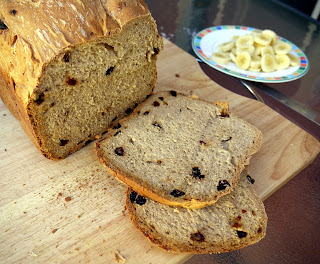It's one of those weekends where you haven't quite run down the fridge enough to justify buying a whole shop of new food, but at the same time you're a bit worried you might run out of food midway through the week. Planning to the rescue! One of our purchases last week was a
huge bunch of silverbeet, and a fairly large bunch of beetroot. While we'd eaten the roots of the latter, the leaves and stalks were still hanging around, and we hadn't even made a dent in the silverbeet. So I googled around, and found
this recipe, added the beetroot stalks, and it worked out remarkably well. In fact the beetroot stalks added a really nice purple colour. For perhaps the first time ever, I managed not to burn the top of the lasagne,
by covering it in foil. Genius (/facepalm).
Ingredients:
- 2kg of silverbeet and/or beetroot stalks & leaves
- 1 large white or red onion
- 4 cloves of garlic
- 3 x 400g tins of chopped tomatoes
- 1 x 50g tin of tomato puree or paste
- 1/2 glass red wine
- 6 tsp dried mixed herbs, or a few handfuls of fresh
- 3 bay leaves
- 2 tsp sugar
- salt and black pepper
- 120g butter
- 100g plain flour
- 1 litre of milk
- 1 cup of grated Parmesan cheese
- 1/4 tsp nutmeg
- lemon juice
- 1/2 cup of cheddar cheese
Finely chop the onion and fry gently in olive oil until translucent and starting to colour. Crush in the garlic, fry for a further minute, then add the tins of tomatoes and puree, rinsing them out with some red wine and a little water. Add the herbs, bay leaves and sugar; stir, cover and cook for an hour, stirring occasionally, until thickened. If it stays too runny, remove the lid to reduce the water content. Taste and season.
While the sauce is cooking, melt the butter in the microwave and add the plain flour, then gently stir in the milk a little at a time. Microwave for a minute or two, stirring every thirty seconds, until it begins to thicken. Add the Parmesan cheese and nutmeg, then again season to taste.

Wash the beet plants thoroughly, then separate the stalks and leaves (you don't have to be exact). Finely chop the stalks and fry in a little olive oil, then cover and steam for a minute or two in their own juices. Meanwhile, roughly chop the leaves, then add to the stalks, cover and steam for a further minute or two until wilted. Drain the cooked beet plants into a colander and squeeze out the liquid with a spatula, or, after it cools, with your hands. The volume will reduce by about half to two-thirds! Squeeze over a little lemon and season well.
When the tomato, cheese and silverbeet are done, begin the lasagne assembly; I prefer the order: tomato, lasagne, tomato, silverbeet, lasagne, cheese, lasagne, tomato, silverbeet, lasagne, cheese; then top with cheddar and cover with foil. Bake at 175 C for an hour, removing the foil for the last 15 minutes to allow the cheese to turn golden. Rest of 10 minutes before slicing.











































